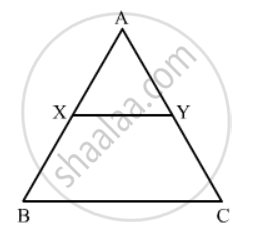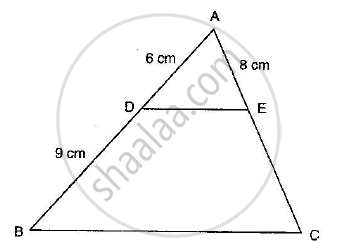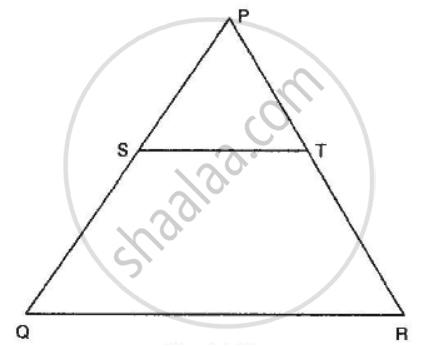Advertisements
Advertisements
प्रश्न
XY is drawn parallel to the base BC of a ∆ABC cutting AB at X and AC at Y. If AB = 4 BX and YC = 2 cm, then AY =
पर्याय
2 cm
4 cm
6 cm
8 cm
उत्तर
Given: XY is drawn parallel to the base BC of a ΔABC cutting AB at X and AC at Y. AB = 4BX and YC = 2 cm.
To find: AY

In ΔAXY and ΔABC,
\[\angle AXY = \angle B \left( \text{Corresponding angles} \right)\]
\[\angle A = \angle A \left( \text{Common} \right)\]
\[ \therefore ∆ AXY~ ∆ ABC \left( \text{AA similarity} \right)\]
We know that if two triangles are similar, then their sides are proportional.
It is given that AB = 4BX.
Let AB = 4x and BX = x.
Then, AX = 3x
`(AX)/(BX)=(AY)/(YC)`
`(3x)/(1x)=(AY)/2`
`AY=(3x xx2)/(1x)`
`AY= 6cm`
Hence the correct answer is `C`
APPEARS IN
संबंधित प्रश्न
A girl of height 90 cm is walking away from the base of a lamp-post at a speed of 1.2m/sec. If the lamp is 3.6 m above the ground, find the length of her shadow after 4 seconds.
ABCD is a trapezium having AB || DC. Prove that O, the point of intersection of diagonals, divides the two diagonals in the same ratio. Also prove that
In ∆ABC, AD and BE are altitude. Prove that\[\frac{ar\left( ∆ DEC \right)}{ar\left( ∆ ABC \right)} = \frac{{DC}^2}{{AC}^2}\]
In ∆ABC, ray AD bisects ∠A and intersects BC in D. If BC = a, AC = b and AC = c, prove that \[DC = \frac{ab}{b + c}\]
In the adjoining figure, find AC.

In the adjoining figure, DE is parallel to BC and AD = 1 cm, BD = 2 cm. What is the ratio of the area of ∆ABC to the area of ∆ADE?
In the given figure, S and T are points on the sides PQ and PR respectively of ∆PQR such that PT = 2 cm, TR = 4 cm and ST is parallel to QR. Find the ratio of the areas of ∆PST and ∆PQR.

The areas of two similar triangles are in respectively 9 cm2 and 16 cm2. The ratio of their corresponding sides is ______.
∆ABC ∼ ∆DEF. If BC = 3 cm, EF = 4 cm and ar(∆ABC) = 54 cm2, then ar(∆DEF) =
If ABC is an isosceles triangle and D is a point of BC such that AD ⊥ BC, then
